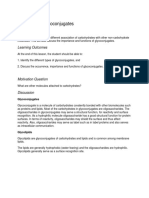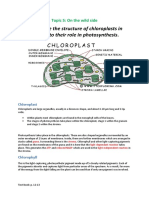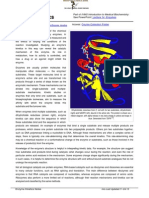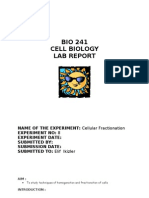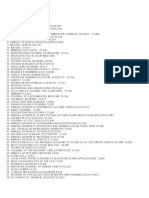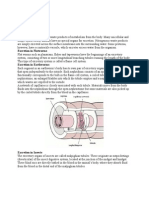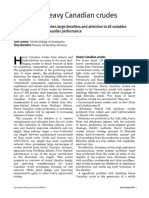Purification Table Instruction
Uploaded by
api-3744715Purification Table Instruction
Uploaded by
api-3744715Purification Table
Instruction
MSUM Biochemistry
Theory and Introduction: A purification table is used after a series of separation steps. This table, similar to
the one you observed in the purification tutorial, is used to present the information about the yield and purity of
the purification. There are only a couple of data needed to prepare the table:
• Volume of each step of the purification, starting from the lysates, to the final pooled sample.
• Total protein (mg) for each step.
• Units (amount) of protein being purified (typically done using the enzyme activity units).
The rest of the information for the table can be calculated from this data.
Example Purification Table
Volume Total Protein Activity Total Activity Specific Activity Fold
Fraction (ml) (mg) (units) (units * ml) (units / mg) Purification % Yield
Lysate 10.00 56.3 65897 658970 1170 1.0 100
DEAE 12.50 25.36 42845 535563 1689 1.4 81
Ni-Agarose 8.25 18.25 51481 424718 2820 2.4 64
S-200 4.30 3.75 48239 207428 12863 11.0 32
Reactive Blue 3.50 1.28 46578 163023 36389 31.1 25
Calculations –
1. Units – Normally, this is determined using an enzymatic assay. MGH has an enzyme, as one of the fusion
partners, but we are determining the fluorescence of the protein as a function of the enzyme. THIS
MUST BE DONE AT THE SAME TIME. You must thaw the fraction of your lysate, pooled samples and
final purification sample and conduct a fluorescent assay at the same time. Different settings on the
plate reader will give you a different result, thus it must be read at the same time using the same plate.
Simply thaw the samples and place 100 µl into a well. Return the samples back to the tube for later assay.
The units of activity will thus be measured as MGH Fluorescence (relative fluorescent units). For
specifics on how to determine enzymatic activity, go to the lab website for that handout.
2. Total Activity – this is a measure of how many units of protein you have in a sample. Simply multiply the
activity in the sample by the total volume.
3. Specific Activity – specific activity is a way to measure how much of a measured protein (MGH in this
case) there is with all of the other contaminating proteins. Divide the Activity by the mg of protein. The
higher this value, the higher purity.
4. Fold Purification – Divide the specific activity of each fraction by the specific activity found in the
lysates. This number changes depending on the protein you are working with. There is no good or bad
value. However, this number along with the percent yield, indicates if a step was worthwhile or not. A
poor fold purification with a low yield is a step to avoid in the future, while a high fold purification and
high yield is a great thing…
5. Percent Yield – Calculate the percentage of the yield for each step using the total activity from the
starting step.
Try setting up an excel spreadsheet using the formulas given above.
1 October 06
You might also like
- Hourglass Workout Program by Luisagiuliet 276% (21)Hourglass Workout Program by Luisagiuliet 251 pages
- The Hold Me Tight Workbook - Dr. Sue Johnson100% (16)The Hold Me Tight Workbook - Dr. Sue Johnson187 pages
- Read People Like A Book by Patrick King-Edited62% (65)Read People Like A Book by Patrick King-Edited12 pages
- Livingood, Blake - Livingood Daily Your 21-Day Guide To Experience Real Health77% (13)Livingood, Blake - Livingood Daily Your 21-Day Guide To Experience Real Health260 pages
- COSMIC CONSCIOUSNESS OF HUMANITY - PROBLEMS OF NEW COSMOGONY (V.P.Kaznacheev,. Л. V. Trofimov.)94% (212)COSMIC CONSCIOUSNESS OF HUMANITY - PROBLEMS OF NEW COSMOGONY (V.P.Kaznacheev,. Л. V. Trofimov.)212 pages
- Donald Trump & Jeffrey Epstein Rape Lawsuit and Affidavits83% (1016)Donald Trump & Jeffrey Epstein Rape Lawsuit and Affidavits13 pages
- The 36 Questions That Lead To Love - The New York Times94% (34)The 36 Questions That Lead To Love - The New York Times3 pages
- The 36 Questions That Lead To Love - The New York Times95% (21)The 36 Questions That Lead To Love - The New York Times3 pages
- Jeffrey Epstein39s Little Black Book Unredacted PDF75% (12)Jeffrey Epstein39s Little Black Book Unredacted PDF95 pages
- The 4 Hour Workweek, Expanded and Updated by Timothy Ferriss - Excerpt23% (954)The 4 Hour Workweek, Expanded and Updated by Timothy Ferriss - Excerpt38 pages
- Training On Dry Fog Dust Suppression SystemNo ratings yetTraining On Dry Fog Dust Suppression System10 pages
- Cmb-Ppt-5-Endoplasmic Reticulum-Borja, Jayven CNo ratings yetCmb-Ppt-5-Endoplasmic Reticulum-Borja, Jayven C11 pages
- Role of Chromatin in Regulating Gene Expression and Gene SilencingNo ratings yetRole of Chromatin in Regulating Gene Expression and Gene Silencing19 pages
- Fatty Acid Catabolism: 1. Digestion, Mobilization, and Transport of Fatty Acids Oxidation 3. Ketone BodiesNo ratings yetFatty Acid Catabolism: 1. Digestion, Mobilization, and Transport of Fatty Acids Oxidation 3. Ketone Bodies13 pages
- Particle Bombartment PPT Tomorw - PPT - Finishing100% (1)Particle Bombartment PPT Tomorw - PPT - Finishing52 pages
- ABC Model of Flower Development - WikipediaNo ratings yetABC Model of Flower Development - Wikipedia9 pages
- Signal Transduction & G Protein-Coupled Receptors: TopicsNo ratings yetSignal Transduction & G Protein-Coupled Receptors: Topics33 pages
- Problems Encountered by Researchers in India50% (2)Problems Encountered by Researchers in India2 pages
- Genetic Engineering Laboratory Manual: Prepared by Lilly M Saleena Department of Bioinformatics SRM UniversityNo ratings yetGenetic Engineering Laboratory Manual: Prepared by Lilly M Saleena Department of Bioinformatics SRM University21 pages
- Experiment III Analysis of DNA by Agarose Gel ElectrophoresisNo ratings yetExperiment III Analysis of DNA by Agarose Gel Electrophoresis20 pages
- Restriction Endonucleases: Restriction Enzyme, Also Called Restriction Endonuclease, A Protein ProducedNo ratings yetRestriction Endonucleases: Restriction Enzyme, Also Called Restriction Endonuclease, A Protein Produced5 pages
- Lecture Notes (Theory and Practice of Sterilization)No ratings yetLecture Notes (Theory and Practice of Sterilization)5 pages
- Denaturation and Renaturation of Ribonuclease - Unit4 A - Lecture - Unit 4No ratings yetDenaturation and Renaturation of Ribonuclease - Unit4 A - Lecture - Unit 418 pages
- Developmental Specification & DifferentiationNo ratings yetDevelopmental Specification & Differentiation14 pages
- Gene Mapping in Bacteria and Bacteriophages: Peter J. Russell0% (1)Gene Mapping in Bacteria and Bacteriophages: Peter J. Russell48 pages
- Expression of Cloned Protein in Animal CellNo ratings yetExpression of Cloned Protein in Animal Cell4 pages
- TD62LM and TD62M Thermodynamic Steam Traps With Replaceable Seats (Screwed /socket Weld)No ratings yetTD62LM and TD62M Thermodynamic Steam Traps With Replaceable Seats (Screwed /socket Weld)2 pages
- Food Premises Design and Construction Standards Plain100% (1)Food Premises Design and Construction Standards Plain14 pages
- Light Weight Spread Filament Multilayer Composite Technology by Chris AdamsNo ratings yetLight Weight Spread Filament Multilayer Composite Technology by Chris Adams28 pages
- Effect of Polypropylene Fibres On Strength and Durability Performance of M-Sand Self Compacting ConcreteNo ratings yetEffect of Polypropylene Fibres On Strength and Durability Performance of M-Sand Self Compacting Concrete22 pages
- Pt100 RTD & Thermocouple Probes For Industrial ApplicationsNo ratings yetPt100 RTD & Thermocouple Probes For Industrial Applications2 pages
- 2019dec-03 - Ionic Equilibrium - PracticeSheetNo ratings yet2019dec-03 - Ionic Equilibrium - PracticeSheet2 pages
- Technical Specification For ASTM 537 Class INo ratings yetTechnical Specification For ASTM 537 Class I6 pages






































